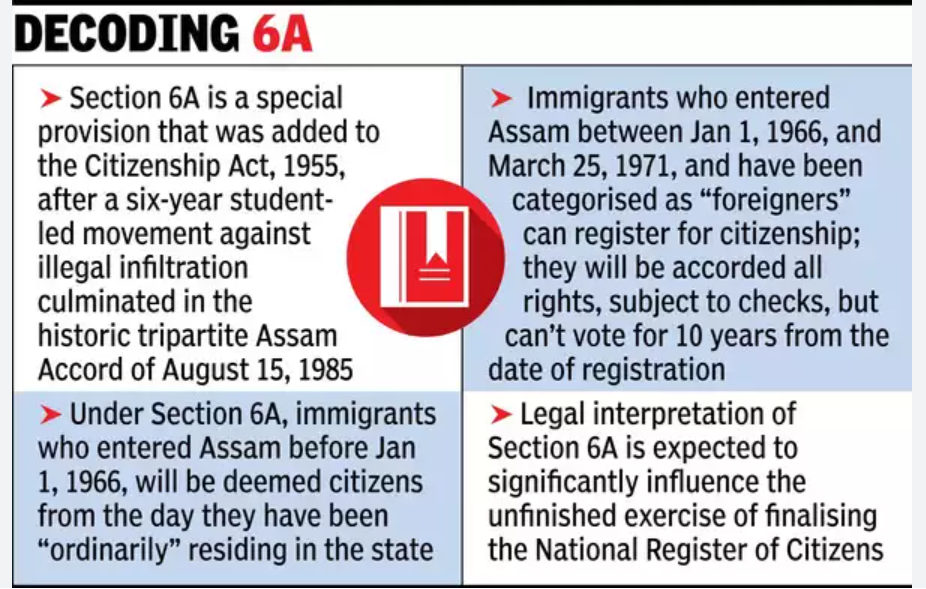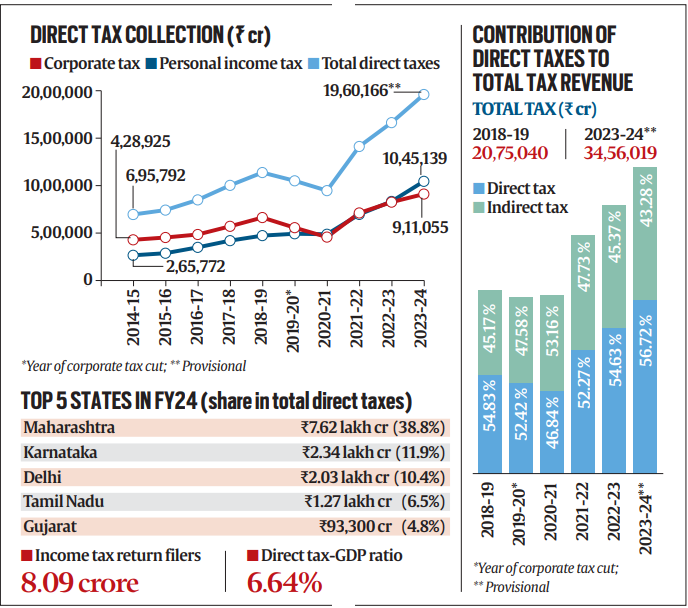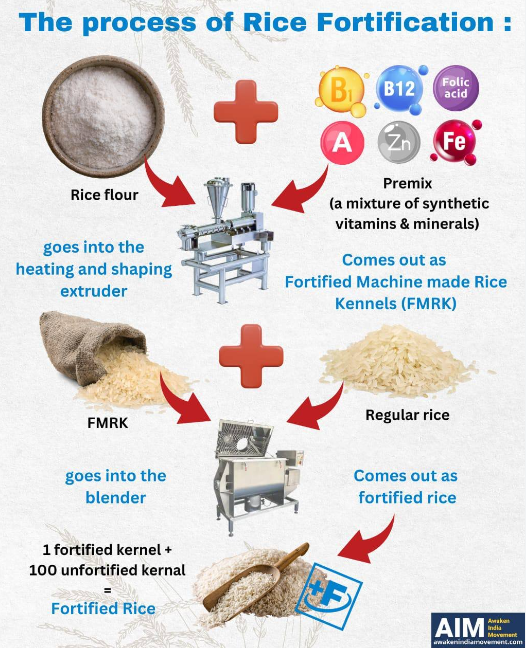18 October 2024 : Daily Current Affairs
1. Supreme Court Upholds Special Citizenship Provisions for Assam Migrants, Affirms Parliament’s Power Over Citizenship Laws
(Source: Indian Express; Section: Explained; Page: 17)
| Context: |
| The article discusses the Supreme Court’s 4-1 verdict upholding Section 6A of the Citizenship Act, which grants citizenship to migrants in Assam up to March 24, 1971, as part of the Assam Accord, affirming Parliament’s authority to regulate citizenship laws. |
Analysis of News:

Overview of the Verdict
- A five-judge Constitution Bench of the Supreme Court, by a 4-1 majority, upheld Section 6A of the Citizenship Act, 1955. This section provides a unique citizenship process for migrants who entered Assam until March 24, 1971, based on the Assam Accord of 1985.
- The decision is significant for Assam, shaped by migration issues, and for wider questions of citizenship and Parliament’s authority in such matters.
What is Section 6A of the Citizenship Act of 1955?

Background:
- Section 6A was enacted as part of the Citizenship (Amendment) Act, 1985, following the Assam Accord of 1985.
- The Assam Accord was a tripartite agreement between the Central Government, the State Government of Assam, and the leaders of the Assam Movement, which sought to end the influx of illegal migrants from Bangladesh.
- The Assam Accord, signed in 1985, introduced Section 6A into the Citizenship Act, of 1955, exclusively for Assam.
- This provision addresses the issue of large-scale migration preceding the 1971 Bangladesh Liberation War. Notably, it mandates the detection and deportation of foreigners who entered Assam after March 25, 1971, marking the creation of Bangladesh.
- The introduction of Section 6A reflects the specific historical and demographic challenges faced by Assam during this critical period.
- Provisions and implications:
- Section 6A created a special provision for Assam by which persons of Indian origin who came from Bangladesh before 1st January 1966, were deemed to be citizens of India as of that date.
- Persons of Indian origin who came to Assam between 1st January 1966, and 25th March 1971, and who were detected to be foreigners, were required to register themselves and were granted citizenship after 10 years of residence, subject to certain conditions.
- Persons who entered Assam after 25th March, 1971, were to be detected and deported in accordance with the law.
Parliament’s Power to Regulate Citizenship
- The Court confirmed that Parliament has the power to regulate citizenship under Article 11 and Entry 17 of the Union List.
- It clarified that Articles 6 and 7, which address citizenship post-Partition, apply only to that period.
- Section 6A, introduced much later, is distinct from these provisions and aligns with Parliament’s powers to legislate on citizenship, which may influence future cases, including challenges to the Citizenship (Amendment) Act, 2019.
Right to Equality and Section 6A
- Petitioners argued that Section 6A violated the right to equality as it applied only to Assam and set an arbitrary cut-off date.
- The Court dismissed this, stating that Assam faced a unique situation due to massive influxes of migrants and cultural threats, which justified a special provision for the state.
- The Court emphasized that other border states were not in similar circumstances.
Does Section 6A Allow Illegal Migration and External Aggression?
- The petitioners cited a previous SC ruling (Sarbananda Sonowal vs Union of India) that described illegal immigration as “external aggression.”
- The Court disagreed, asserting that Section 6A regulates migration in a controlled manner and does not promote “unabated” immigration or amount to external aggression.
Cultural Rights of Assamese People
- The petitioners argued that Section 6A violated Article 29(1), which protects cultural rights, by changing Assam’s demography and threatening Assamese culture.
- The majority rejected this, stating that the mere presence of different ethnic groups does not erode the cultural rights of the indigenous population.
- The Court emphasized national fraternity and cohesion, dismissing the argument of cultural threat.
Conclusion
- This judgment reaffirms Parliament’s legislative powers over citizenship, while addressing Assam’s unique situation regarding migration and demographics.
- It also provides important insights into how the Court views the balance between regional cultural concerns and national integration.
| Demographic Impact & Cultural Impact |
|
|
PYQ: With reference to India, consider the following statements: There is only one citizenship and one domicile. A citizen by birth only can become the Head of State. A foreigner once granted citizenship cannot be deprived of it under any circumstances. Which of the statements given above is/are correct? (a) 1 only Ans: (a) |
| Practice Question: Discuss the constitutional validity of Section 6A of the Citizenship Act, 1955 in light of the recent Supreme Court judgment. How does this provision address the unique migration and demographic concerns of Assam, and what are its implications for the broader citizenship laws in India? (250 words/15 m) |
2. Supreme Court questions logic behind exception to marital rape in penal law
(Source – The Hindu, International Edition – Page No. – 6)
| Topic: GS2 – Indian Polity – Judiciary |
| Context |
|
Analysis of News:
Concerning Statistics
- Data on marital rape remains limited due to stigma and legal barriers, but available statistics are alarming.
- The National Family Health Survey-5 (conducted between 2019 and 2021) indicates that nearly one-third of married women aged 18-49 in India have experienced physical or sexual violence from their husbands.
- Global statistics show that approximately three-quarters of all sexual assaults occur within intimate settings, often perpetrated by someone familiar to the survivor.
Historical Background of the Exception
- The marital rape exemption is a colonial relic rooted in the “doctrine of coverture” from English common law, which severely restricted a married woman’s legal autonomy.
- The Supreme Court highlighted this in the 2018 case of Joseph Shine versus Union of India, where it was noted that the doctrine treated the husband and wife as a single entity, thus suspending the woman’s legal existence.
- British jurist Matthew Hale codified this exception in the 18th century, claiming that a husband could not rape his wife due to their mutual consent.
- England abolished the marital rape exemption in 1991 with the landmark case of R versus R, recognizing that the common law doctrine no longer reflected the reality of a wife’s position in society.
Legal Framework and Challenges
- Section 375 of the IPC outlines conditions for sexual intercourse to be deemed rape, including instances of lack of consent or coercion.
- The law includes two exceptions: one related to medical procedures and the other regarding sexual acts with a wife over 18.
- The Supreme Court raised the minimum age from 15 to 18 years in Independent Thought versus Union of India (2017).
- The exception creates a legal fiction, preventing prosecution even when all elements of rape are present if the parties are married.
Petitioners’ Arguments
- Petitioners argue that the exception is unconstitutional, violating fundamental rights, particularly Article 14, which guarantees equal protection under the law.
- The exemption creates two classes of victims, denying married women the same protections as unmarried women and thus undermining substantive equality, violating Article 15(1).
- Concerns about violations of the right to privacy and bodily integrity under Article 21 are also raised.
Judicial Precedents
- In 2022, the Karnataka High Court ruled that a married man could be prosecuted for raping his wife, relying on the Justice J.S. Verma Committee’s recommendations.
- The Delhi High Court delivered a split verdict on the issue, with one justice deeming the exception unconstitutional, while the other upheld it as consistent with marital norms.
- The Supreme Court previously recognized that “sexual assault by a man against his wife can constitute rape.”
Government Stance
- The Union government has officially opposed the striking down of the marital rape exemption, arguing that marriage implies a “continuing expectation of reasonable sexual access.”
- The government contends that classifying marital sex as rape is “excessively harsh” and could undermine the institution of marriage, potentially leading to false allegations.
Creation of a New Offence
- A key question for the Supreme Court is whether abolishing the exception would create a new offence.
- Justice Shankar cautioned against this, asserting that such authority lies solely with the legislature.
- Advocates argue that deeming the exception unconstitutional would not create a new offence, as non-consensual sex already constitutes an offence; it would merely revoke the legal immunity currently enjoyed by husbands.
| Issue of Criminalising Marital Rape: |
|
Arguments in Favour of Criminalising Marital Rape:
Arguments Against Criminalising Marital Rape:
|
| Practice Question: Discuss the legal and social implications of criminalizing marital rape in India. What are the key arguments for and against this step? (150 Words /10 marks) |
PRELIMS FACTS
1. Deep-Sea Marine Heatwaves Uncovered: Global Warming Intensifies Ocean’s Twilight Zone Warming
(Source: Indian Express; Section: Explained; Page: 17)
| Context: |
| The article discusses a study revealing how global warming is intensifying marine heatwaves in the deep ocean’s twilight zone, driven by eddy currents, with potential ecological impacts. |
Analysis of News:

Marine Heatwaves (MHWs) and Their Occurrence
- Marine Heatwaves (MHWs) refer to episodes of unusual warming in ocean waters, typically monitored by measuring the surface temperature.
- The challenges of deep-sea exploration, including the lack of sunlight and high pressures at great depths, have traditionally limited observations to the ocean’s surface.
Impact of Global Warming on MHWs
- Global warming has intensified the frequency and severity of MHWs.
- A recent study published in Nature reveals that these heat waves also affect the ocean’s “twilight zone,” situated between 200 and 1,000 meters below the surface.
- This deep-sea warming phenomenon is significantly underreported due to limited deep-sea data collection.
Study Methods and Findings
- The study utilized long-term moorings and Argo floats—robotic devices that dive to depths of up to 2,000 meters—to sample temperature and salinity.
- The research highlighted that eddy currents, rather than atmospheric factors, are the major influencers of temperature fluctuations in the deep ocean.
- Eddies, large swirling loops of water that extend to great depths, transport warm and cold water across long distances, and global warming is intensifying these eddy currents.
Ecological Concerns
- The warming of the twilight zone raises concerns for marine life, particularly plankton and fish species that form the foundation of the oceanic food chain.
- Marine heatwaves can reduce oxygen levels and nutrient availability, posing threats to the overall marine ecosystem.
2. Direct Taxes Reach 14-Year High, Personal Income Tax Surpasses Corporate Tax in FY24
(Source: Indian Express; Section: Economy; Page: 15)
| Context: |
| The article highlights a significant increase in India’s direct tax contribution to total revenue in FY24. |
Analysis of News:

Direct Tax
- Direct Tax refers to the type of tax that is borne by a person/entity on whom it is levied.
- Thus, in this case, the Impact of Tax and the Incidence of Tax fall on the same person or entity. In other words, the burden of a Direct Tax cannot be shifted to another person or entity.
- Direct Taxes in India is administered by the Central Board of Direct Taxes (CBDT), which is a part of the Department of Revenue (under the Ministry of Finance).
Surge in Direct Tax Contribution
- In 2023-24, the share of direct taxes in India’s total tax revenue reached 56.72%, marking a 14-year high. The direct tax-to-GDP ratio also hit a two-decade peak at 6.64%.
- This shift reduced the share of indirect taxes in the overall tax revenue to 43.28%, as direct taxes are viewed as more progressive, being linked to income levels, unlike indirect taxes, which are applied universally and disproportionately affect lower-income groups.
Shift in Tax Composition
- A notable trend observed is the continued rise in personal income tax collections, surpassing corporate tax collections for the second consecutive year in FY24.
- Personal income tax collections amounted to ₹10.45 lakh crore, outpacing corporate tax collections of ₹9.11 lakh crore.
- This reversal began following the government’s corporate tax rate cuts in 2019, which reduced the corporate tax rate to 22% for existing companies and 15% for new companies.
Tax Buoyancy and Collection Efficiency
- Tax buoyancy, which measures the growth of taxes relative to the economy’s nominal growth rate, increased significantly to 2.12 in FY24, from 1.18 in the previous year.
- The cost of tax collection also dropped to 0.44%, the lowest since 2000-01, indicating improved efficiency, though the absolute cost rose to ₹8,634 crore due to an overall increase in tax collections and the number of income tax return filers.
3. Nobel winner Han Kang hopes her life ‘won’t change much’
(Source – The Hindu, International Edition – Page No. – 15)
| Context |
|
Analysis of the news:
- Han Kang, a South Korean novelist, won the 2024 Nobel Prize in Literature, becoming the first Asian woman to receive this prestigious award.

Her win marks a significant moment in South Korean literary history.
She is celebrated for her “intense poetic prose” that addresses historical traumas and the fragility of human life.
Han is known for notable works like “The Vegetarian” and “Human Acts,” which explore violence and societal issues in South Korea.
Following the announcement, her books saw a surge in sales, with over 800,000 copies sold.
Han has remained low-profile post-award, emphasising her focus on writing while acknowledging the ongoing wars in Gaza and Ukraine
4. Fortified Rice: Centre’s ambitious initiative to combat micronutrient deficiencies
(Source – https://pib.gov.in/PressReleseDetail.aspx?PRID=2065835®=3&lang=1 )
| Context |
|

Government Policy Regarding Fortified Rice
- The Union Cabinet approved the continuation of the fortified rice initiative under various welfare schemes from July 2024 to December 2028.
- A total of 520 Lakh Metric Tons (LMT) of fortified rice is to be procured annually under the Pradhan Mantri Garib Kalyan Anna Yojana (PMGKAY).
- Over 21,000 of the 30,000 operational rice mills have installed blending equipment, with a production capacity of 223 LMT of fortified rice monthly.
- Scientific assessments indicate that fortified rice is safe for all individuals, including those with hemoglobinopathies like Thalassemia and Sickle Cell Anaemia, leading to the removal of unnecessary advisory labels on packaging.
| What is Fortified Food? |
|
Fortified food refers to food products that have been enhanced with essential vitamins, minerals, or other nutrients to improve their nutritional value. The fortification process aims to combat nutrient deficiencies prevalent in populations, particularly in staple foods.
|
How Fortified Rice Can Solve Issues in India
- Rice fortification is essential in India, where 65% of the population consumes rice daily, addressing micronutrient deficiencies, particularly iron.
- Fortified rice can help reduce anaemia rates, especially among vulnerable groups such as women and children.
- The initiative aligns with global practices, improving overall public health outcomes by providing a simple and effective means of enhancing diet quality.
| Practice Question: Discuss the significance of iron-fortified rice in addressing micronutrient deficiencies in India. Evaluate the government’s policy initiatives regarding rice fortification and its possible advantages. (150 Words /10 marks) |
5. Government will take all measures for the preservation and development of the Pali language
(Source –https://pib.gov.in/PressReleseDetail.aspx?PRID=2065892®=3&lang=1 )
| Context |
|

Pali Language
- Origin: Pali is an ancient Indo-Aryan language, derived from Sanskrit, primarily associated with Theravada Buddhism.
- Script: Pali is commonly written in the Brahmi script, as well as other scripts like Roman and Sinhala.
Buddhist Literature in Pali
- Tipitaka (Three Baskets): The foundational scripture of Theravada Buddhism, comprising:
- Vinaya Pitaka: Rules for monastic discipline.
- Sutta Pitaka: Discourses attributed to the Buddha and his disciples.
- Abhidhamma Pitaka: Philosophical and doctrinal analysis.
- Suttas: Key texts include the Dhammapada, a collection of verses on ethical conduct and wisdom.
- Jataka Tales: Stories of the Buddha’s previous lives, emphasising moral lessons.
- Commentaries: Important commentaries like the Visuddhimagga (Path of Purification) provide interpretations of texts and teachings.
- Influence: Pali literature has significantly shaped Buddhist thought, philosophy, and practice across Asia.
| Practice Question: Discuss the significance of the Pali language in preserving Buddhist literature and its impact on the spread of Theravada Buddhism. (150 Words /10 marks) |



